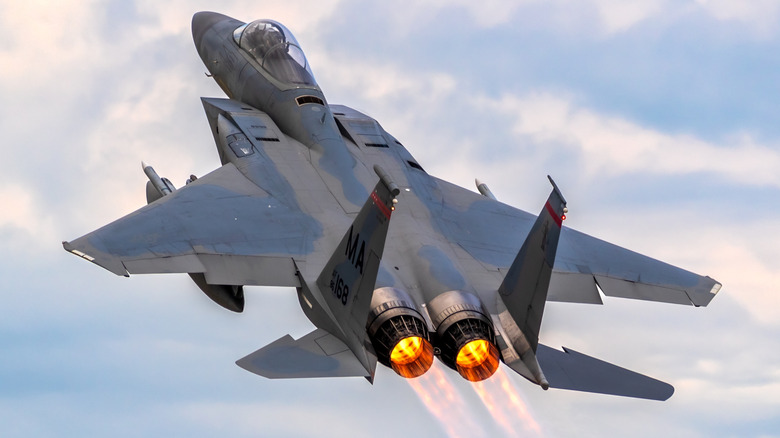Anyone who has lived near an airport can attest that airplane engines are loud. If you’ve ever lived near a military air base, you know that fighter jets can have some of the loudest. The turbulence from the high-velocity air exiting the engine causes the bulk of the noise. Couple that with the noise of the engine components functioning and you get a loud, unpleasant sound. Think of a vacuum cleaner. Obviously jet engines perform a bigger task than vacuums, but even that small household item can be a nuisance. Imagine that on a larger scale.
Advertisement
Modern fighter jets use turbofan engines, aka bypass engines, the same as commercial planes. The fan at the engine’s front sends air into the core, where it’s condensed and heated. Meanwhile, another portion of air, known as the cold air stream, travels along the core’s outside, producing additional thrust. There are two types of bypass engines: high-bypass and low-bypass. Commercial airlines use high-bypass engines while fighter jets use low-bypass. A low-bypass engine sends a considerable amount of the air it takes into the core, with a very small portion around it.
More powerful engines produce more noise since they take more air in at a higher rate. When a fighter jet uses its afterburner, it produces significantly more noise. Depending on the fighter jet, the distance away a person stands, and whether it’s using an afterburner, their sound levels can range from 140 to 153 decibels.
Advertisement
Fighter jets cause noise complaints
Reaching 150 dB can rupture a listener’s eardrum, which has caused some to complain about the noise coming from military bases. Residents of Dane County, Wisconsin, can attest to this, as they’ve complained about the noise coming from Truax Field Air National Guard Base, home of the 115th Fighter Wing. The fighter wing primarily uses F-16 Falcon fighter jets, which produce 145 dB without the afterburner and 150 dB with it. The complaints got even more frequent when F-35s and their incredible turbofans showed up in April 2023.
Advertisement
“I don’t know if it is the fight or flight (reflex), or the adrenaline, or what it is, but it starts as (the plane) is coming closer and closer,” Tom Berman, a homeowner in the area since 1984, told Madison, Wisconsin’s Capital Times. “And then if you’re unlucky enough to be outside it is very unpleasant. It hurts.”
Like the F-16, the F-35 produces 145 dB without engaging its afterburner; it goes up to 148 db with it.Even before the F-35s arrived, when it was just F-16s, the National Guard [PDF] had to distribute literature that explained the noise.
The weather plays a big role in fighter jets’ din, too. “Low hanging clouds can trap noise,” according to Luke Air Force Base, making fighters sound even louder than they actually are. The wind might blow in a different direction, as well, making fighter jets louder for a neighborhood than the day before.
Advertisement
There are endeavors to decrease jet engine noise
The U.S. military and NASA aren’t oblivious to the onslaught of noise complaints. Multiple organizations have studied the sound jets produce, and contractors have made strides in reducing it.
NASA [PDF] published a study in 2007 that researched methods for trimming turbofan engines’ noise. NASA has focused primarily on high-bypass engines used on commercial aircraft, such as a Gulfstream III.
Advertisement
Some researchers, on the other hand, have looked at fighter-jet engines specifically. “The main purpose is to reduce the impact on neighboring communities,” said Ephraim Gutmark, a professor at the University of Cincinnati College of Engineering and Applied Sciences. “The Navy had a big lawsuit in Norfolk, Virginia, from people who lived near the base and complained about hearing problems, sleeping problems and the diminished value of their properties. So the military has to limit its operations and stop operating at certain times of day. It’s a severe problem.”
The university worked alongside the U.S. Navy and GE Aircraft Engines in 2011 to implement mechanical chevrons (serrations at the exhaust nozzle’s rim) and fluidics (injections of air along the rim) as a way to reduce noise. There was some success with this project, prompting it to continue. The real struggle seems to be reducing noise without sacrificing engine power.
Advertisement







